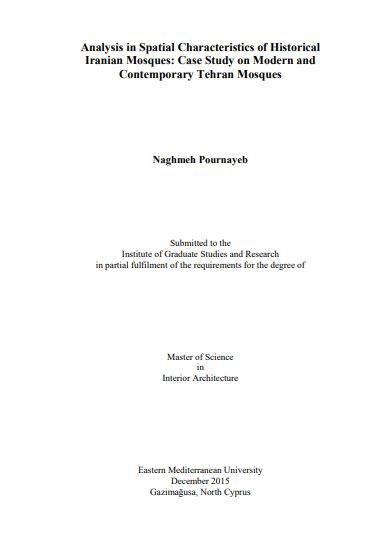
Mosques are not only a place for worship, but also a spiritual space in which Muslims can seek their creator in solitude and reach an internal peace. From the early days of Islam until the present time, mosques have undergone many changes in terms of appearance, spatial characteristics and organization of space. Since investigation and analysis of all the mosques in world is not possible, the researcher had to limit the research to the Iran capital city (Tehran) for a more precise study. Nine mosques in Tehran were selected as the case study in the present research. Their spatial characteristics were investigated based on the charateristics of Iranian mosques in the modern and contemporary periods (1796- 2015 AD). In the first chapter, the history of different religions in the world is studied. Abrahamic religion has the most followers in the world. Islam is the last Abrahamic religion that exists in the world. The research was conducted using literature survey, field observations and comparison of case studies. Thus, it has employed a qualitative methodology for its purposes. A limitation of this study was to evaluate the spatial characteristics of Iranian mosques and factors affecting their design within the limited time duration of 150 years. Tehran was selected as a case study in this research and nine mosques were randomly surveyed. General theoretical explanations about mosques around the world are presented in the second chapter. Accordingly, different types of religions are firstly studied. Finally, the spatial characteristics of mosques including, elements, spaces and ornaments are explained. In the third chapter, the effective factors on the spatial properties of Iranian mosques including architectural styles, Iran’s different historical periods, government, politics and Iranian culture are studied in the first part. In the second part, the spatial changes occurred in the modern and contemporary Iranian mosques including elements, spaces and ornaments are studied. The fourth chapter of this study is related to the analysis of and discussion on existing mosques in each category. In the category of early modern mosques (1879-1963), the architecture of Qajar (1879) and first Pahlavi (1925) periods are analyzed. Also in the category of High modern period (1963- 1998), the architecture of second Pahlavi (1963) and early period of the Islamic Republic (1979) are studied. Finally, in the category of contemporary mosques (1998- 2015), the architecture of mosques in the Islamic Republic are discussed. In each category three mosques are randomly selected and discussed. In the fifth chapter, which is the conclusion section, the analyses conducted in each main category are compared, and at the end, their impacts on the mosque’s architecture are expressed. This study showed that there is a great dynamism in the mosque architecture during last 150 years and Iran is divided into three categories: Early Modern era that is from the mid Qajar, by changing the design of traditional mosque plan, construction of mosques at the beginning of first Pahlavi inclined more toward modernization. High Modern era, that in second Pahlavi reign, Islamic architecture in a novel form has emerged in modernism. With the beginning of the Islamic Republic mosques had a tendency toward traditionalism. In Contemporary era, which in Islamic Republic mosques are more updated and tailored to social needs and new functions. This study shows that there is a great dynamism in mosque architecture in last 150 years. Although the main requirments of a mosque is still the same changes in aesthetic understanding, building techniques and materials and same other factors have resulted with brand new mosque appearances in Tehran, Iran. Keywords: Mosque architecture, spatial characteristics, Modern and Contemporary Mosque, Ornamentation and Iranian Mosques.
Pournayeb, N., ‘Analysis in Spatial Characteristics of Historical Iranian Mosques: Case Study on Modern and Contemporary Tehran Mosques’ (Unpublished Master Thesis: Eastern Mediterranean University, 2015).
I agree to the terms outlined below:
You agree to upload and assign Mosqpedia Database the rights to use the content worldwide and in perpetuity across all current and future media platforms. Mosqpedia Database may edit, copy, adapt and translate your contribution.
The content will be distributed under the Creative Commons Attribution-Deed – Attribution-NonCommercial-NoDerivatives 4.0 International – Creative Commons
All data will be stored in line with data protection regulations.